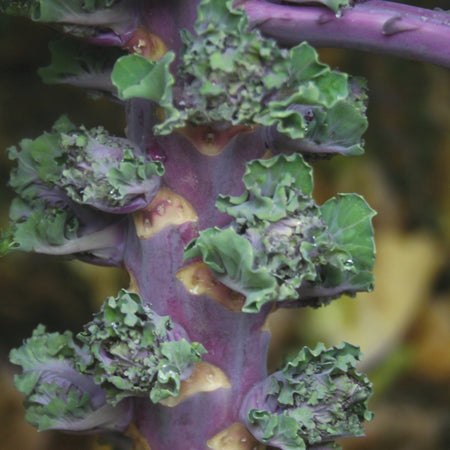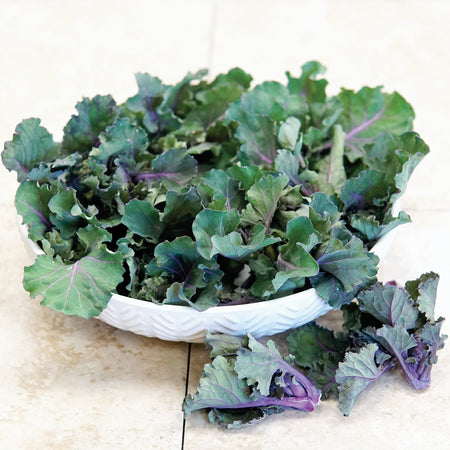AUTUMN STAR KALETTES®
Product Description:
| Soil Temp for Germ | 55–75°F |
| Seed Depth | ¼" |
| Seed Spacing | 4–6" |
| Days to Emergence | 5–17 |
| Thin Plants to | 24" |
| Row Spacing | 18–36" |
| Fertilizer Needs | High |
| Minimum Germination | 75% |
| Seeds per Gram | ≈ 240–340 |
| Seed Life | 3–4 years |
Brassica oleracea, Gemmifera Group. These mini cabbage look-alikes are packed with health-promoting goodness. Just over a cup of these flavorful 'buttons' contain nearly 150% of the RDA of vitamin K. They're also loaded with dietary fiber and the metabolite, indole-3-carbinol, an effective immune regulator, anti-bacterial & anti-viral agent.
Days to maturity are calculated from June 15th transplant.
Culture
• Brussels sprouts perform best in cool weather and in fertile, well-drained soils
• Proper timing is needed in order to grow large mature plants, which then develop buds during cooler fall weather
• Provide plants consistent, even water (1 inch per week)
• Brussels Sprouts benefit from high fertility early in development and less as they mature (use a slow release fertilizer at transplant and later only if symptoms of deficiency occur)
Direct Sowing
• Not recommended
Transplanting
• Start indoors 4-6 weeks before your anticipated transplant date
• While Brussels Sprouts can be started in summer and transplanted as late as September, to achieve the largest stalks and highest yield, we recommend sowing mid-May and transplanting mid-June
• At transplant, work in 1/2 cup of TSC's Complete fertilizer around the base of each plant
Insects & Diseases
• Common insects: See Brassica Insect Information below
• Disease prevention: 5-7 year crop rotation
Harvest & Storage
• Brussels sprouts are best after a couple of frosts
• Mature buds should be 1-1 1/2 inch, firm and well formed
• Begin picking sprouts from the bottom; upper sprouts will continue to mature as lower ones are harvested
• Alternatively, you can mature the entire stalk by cutting off the top at the growing point when sprouts are present throughout and bottom sprouts are 1/2 inch in diameter; sprouts will mature within a couple weeks
• Store at 36°F and 100% relative humidity
Brassica Insect Information
Aphids: Control aphids with ladybugs or a hard spray of water or Pyrethrin. Also, select varieties that mature later in the season when aphid populations decline.
Cabbage worms, loopers, and root maggots: The first sign of cabbage worms will be off-white butterflies fluttering near the plants. They lay their yellowish-colored eggs on the undersides of leaves, which hatch into caterpillars that can cause severe root and head damage. To control light infestations, spray plants with Bacillus thuringiensis (B.t.). For heavy infestations, bait cabbage worms by mixing wheat bran into a B.t. solution. Add 1 tablespoon of molasses. Broadcast the bran mixture around the base of plants. Reapply as necessary. Using Reemay or Summer Insect Barrier can also provide control.
Flea beetles: Flea beetles chew tiny pinholes in leaves. Early control is essential to minimize the damage. Spray infected plants with Pyrethrin. Using floating row covers such as Summer Insect Barrier can also provide control.
Symphylans: In some areas of the US, symphylans (also known as garden centipede) can severely impede the plant growth of many crops. Only 1/4 inch long, white, and very active, they eat the root hairs of developing plants. Using larger transplants helps reduce damage. Contact your local county extension agent if you suspect you have a problem.




